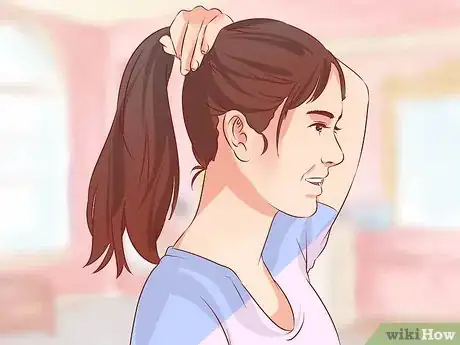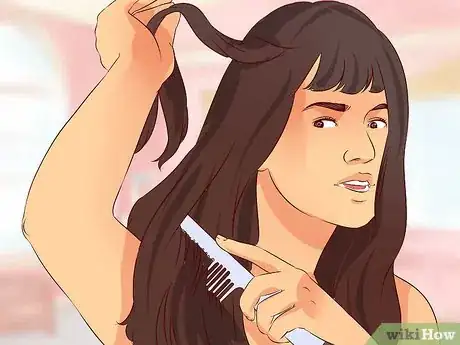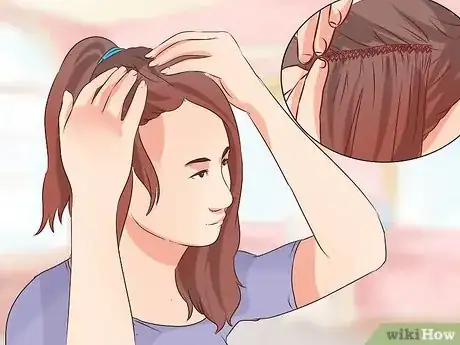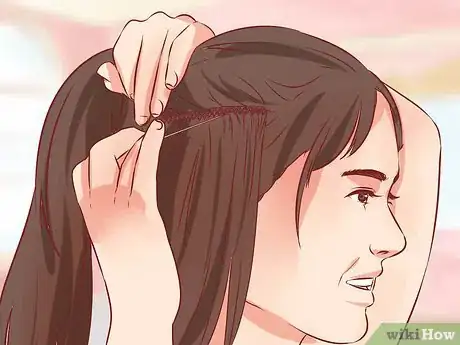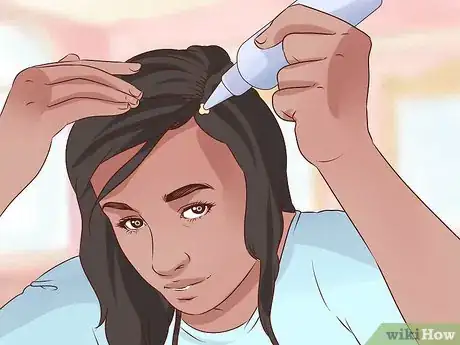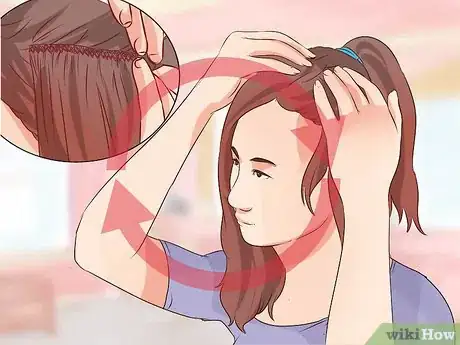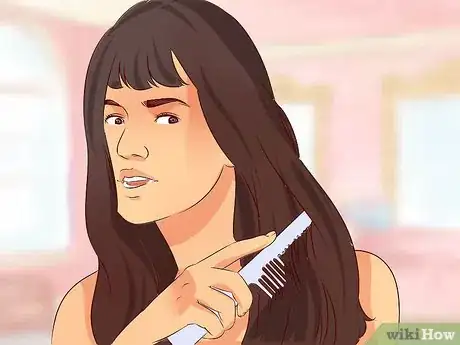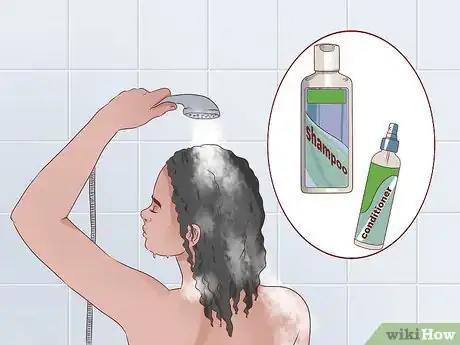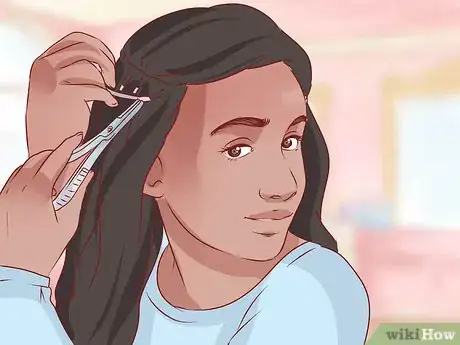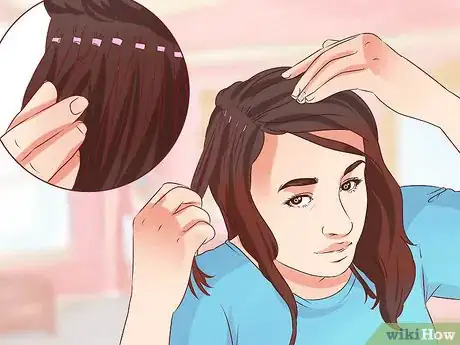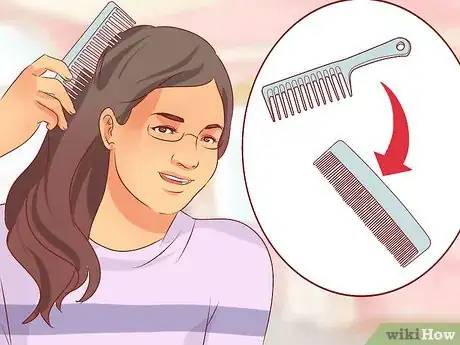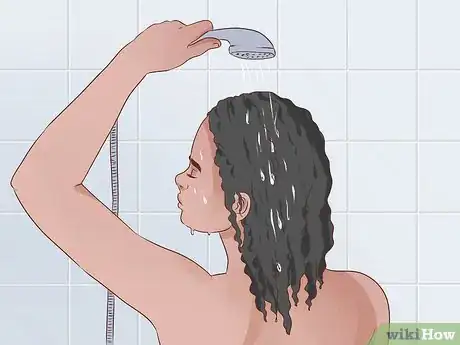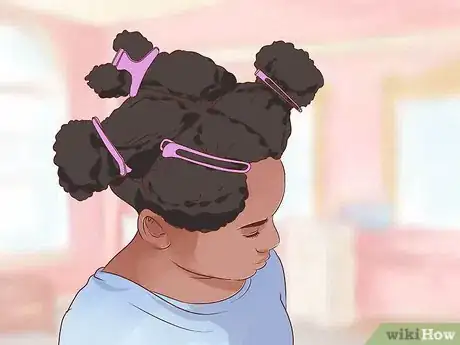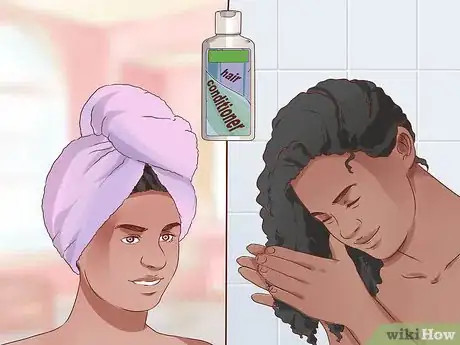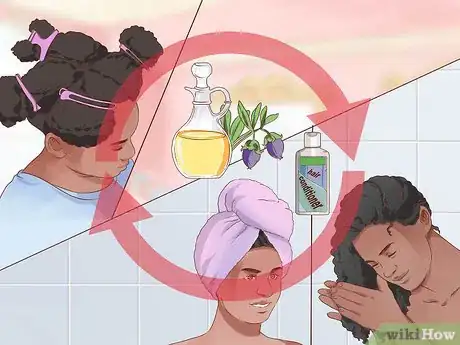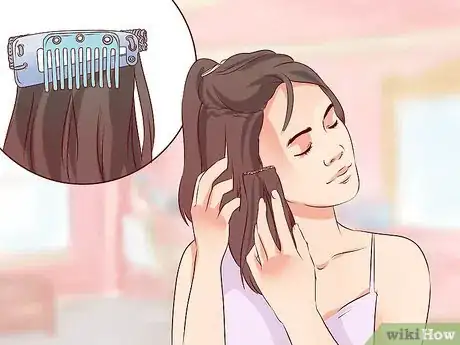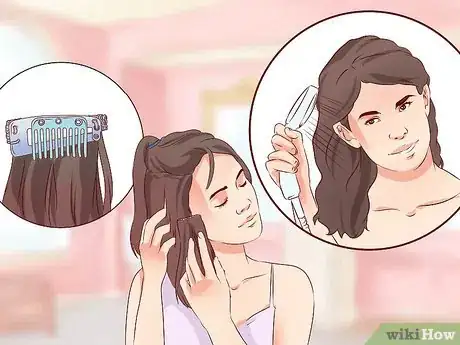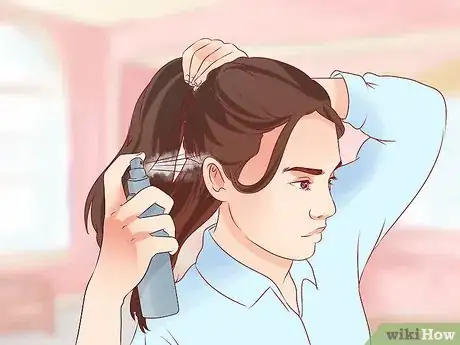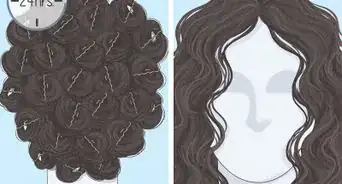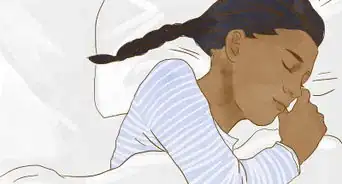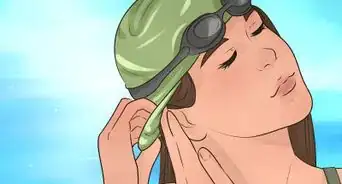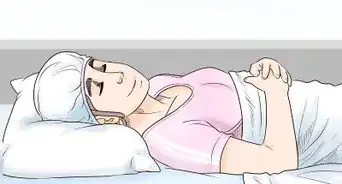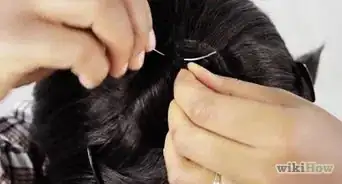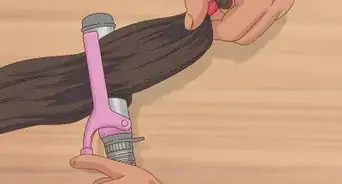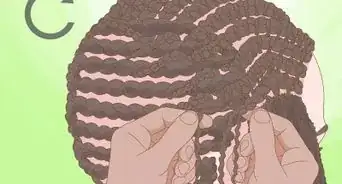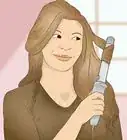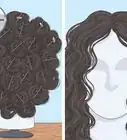This article was co-authored by Madeleine Johnson. Madeleine Johnson is a Hair Stylist and Hair Extensions Specialist based in Beverly Hills, California. She is affiliated with Hair by Violet Salon in Beverly Hills. Madeleine has over six years of hairstyling experience as a licensed cosmetologist. She specializes in microbead extensions and tape-in extensions. She trained under celebrity extension artist Violet Teriti (Chaviv Hair) and earned her cosmetology license from Santa Monica College.
This article has been viewed 385,636 times.
Hair extensions offer the ability to have immediately long and full hair, which is convenient for weddings, proms, or other special occasions. Extensions are not meant to be permanent and need to be taken out eventually. Whether your extensions are clip-in or keratin based, you want to be careful so that you don’t damage your natural hair.
Steps
Undoing Sewn-In Extensions
-
1Gather all of your hair into a ponytail. Take all of your natural hair as well as any extensions and pull them together into one or two hair ties or big hair clips at the top of your head. If you can, try to group your natural hair and your extensions in separate clips.
-
2Separate a section of your hair from the ponytail. It will be too overwhelming to try and rip out all of your extensions at once, so you want to pull out separate rows of hair at a time. Start with a small section at the base of your head at the nape of your neck.[1]
- Use a rat tail comb, or a comb with a long pointed end, to pull out an even section of hair.
- Start at the bottom of your head and gradually let down your ponytail so you can keep track of where you’ve already removed extensions.
Advertisement -
3Use your fingers to find the end of a thread and snip it out. Your extensions will be pulled snug against your scalp with a thread. Lightly run your fingertips along the ridge of the braid or seam where the extension was sewn to find the end. Use needle nose scissors or manicure scissors to isolate the thread from your hair and cut it.[2]
- Use a mirror to find the end of the thread or ask a friend to locate it so you cut the thread and not your natural hair.
- You may still end up cutting 2-3 strands of your natural hair out if it has grown out around the seam.[3]
- Be careful and use the end of your scissors to cut the thread. This will help keep you from cutting too much of your hair. The thread should be pretty loose, so it should not be hard to distinguish between it and your hair.
-
4Unravel the thread away from your scalp. Use both hands to gently pull the extension away from your scalp. One hand should hold your natural hair roots to your scalp in order to prevent breaking or damaging your hair. With your other hand, firmly grasp the extension thread and lightly pull it in the opposite direction to unravel the sewing.
- Work your fingernails or a thin object like a nail file to wiggle in between the braid to help loosen the seam.
- You may need to cut another section of the thread if there are tangles of matting from your natural hair growing around the extension seam.
-
5Use a special hair products to dissolve the threads. Some extensions have threads that can be coated with a salon product that breaks down threads without damaging your natural hair. Spray a section of weave or extension thread with the solution and let it sit for a few minutes.[4]
- Work from the bottom of your head to the top and use a wide toothed comb to pull any debris out of your hair when you’re finished.
-
6Continue finding threads one by one and remove them. Gradually pull out a little of your ponytail to work on individual sections of your hair. Go slowly so that you don’t miss any pieces of weave or extensions that may be hidden in your natural hair. It’s better to be patient than to find a chunk of hair hanging by a thread later.
- If you have extension pieces that are not damaged or ragged, set them aside. They may be able to be reused another time.
-
7Unravel and comb out your natural hair. Once you’re finished taking the thread out, unravel any cornrows or other braids that were used to secure your extensions. Then use a wide toothed comb to make sure that you have removed all artificial hair or materials, Comb from the top to the bottom of your hair and go from one side of your head to the other. Spray hair detangling solution on any tangles or pieces that are proving to be difficult to remove.
-
8Shampoo and condition your hair afterwards. Your hair needs some time to heal itself after the stress of artificial products. Wash your hair with a clarifying shampoo and then use a deep conditioner to help put nutrients back into your hair and scalp.[5]
- Wait at least two weeks before putting more extensions in your hair to let your roots recover.[6]
- As you wash your hair, be on the lookout for any extension remnants that may have slipped through your notice.
Breaking Down Keratin Extensions
-
1Pull your hair together with a large clip or hair band. A ponytail will help keep you organized as you work on finding each keratin bond. Some bonds may be obvious and some may be more difficult to find so you want to work on a small piece of your scalp at a time to avoid missing anything.
-
2Untie a section of your hair starting at the nape of your neck. Use your index finger or the thin end of a salon comb to pull out an even row of hair at the bottom of your head. If you encounter any tangles, pull out a little more hair from your ponytail so you can work on the larger section all together.
- Don't try to remove several hair extensions at once. You'll be able to remove hair extensions much more easily and safely if you work slowly and diligently.
-
3Crimp the bonds with pliers to loosen and break them. Isolate one keratin bond and use needle nose pliers to squeeze the bond. The bond will crack when enough force is applied and it will be easier to release your natural hair from it. After the first crack, move the pliers around the bond and squeeze a different section of it to weaken more of the bond.
- Crush the bond as many times as needed to loosen its grip on your natural hair.
- Lightly twist the pliers if you have stubborn bonds but be careful not to pull hair out of your scalp.
- After removing all of your extensions, some of the cracked bond may still be in your hand if it shattered, so use a fine toothed comb to weed out any debris.
- Simply brushing your hair will not help to remove keratin bonds. Instead, it will damage your natural hair and roots.
-
4Rub oil on the keratin bonds. Use your fingertips and rub any combination of olive, coconut, baby, or almond oil into the cracks of the bonds you created with the pliers. Let the oil seep in and sit for 10-15 minutes. The oil will break down the keratin and allow you to pull or gently comb the extensions out.
- Instead of a household oil, use a specifically designed keratin bond remover from a salon or beauty supply store.
- A small amount of acetone or other alcohol-based gel on the bond can help as well. Just use a small dab so that you don’t damage your scalp with too much alcohol.
-
5Heat the bonds with a hair dryer. To help speed up the chemical process of applying oil to the bonds, blow dry your hair on a low setting. Anywhere from 5 to 15 minutes will be helpful as heat makes bonds more malleable and easy to slip off.
-
6Pull your natural hair away from the bond. Keep in mind that as you pull on the keratin bonds, you want to keep your natural hair from being pulled with the keratin bond. Hold your scalp and the base of your roots with one hand while you lightly pull the bond with the other hand. If you feel too much of a pull on your scalp, try re-cracking the bonds and applying more oil.[7]
-
7Comb your hair with a wide toothed comb and then a fine toothed comb. Use a combination or combs or brushes to help pick out any leftover bonds or extension leftovers. Overall, combs work better than brushes since they have stiffer teeth but a metal brush can also work as well.
-
8Wash and treat your natural hair. Take a shower and use a clarifying shampoo and deep conditioner to help restore your hair, roots, and scalp. Clarifying shampoos will help remove the excess olive oil as well as remaining glue from the weave while the conditioner replenishes any nutrients a harsh alcohol or chemical may have stripped away.
Removing Taped or Glued Extensions
-
1Separate your hair into workable sections. Use a hair clip or tie to pull all of your hair together except for one section. Find the first and closest section of artificial hair at the bottom of your head. You want to start at the bottom and work your way up so you know where you’ve already removed extensions.
-
2Let oil sit on a section of glue or tape for 15 minutes. Oil helps break up any chemical bonds from glue or tape. Use either almond oil, coconut oil, baby oil, olive oil, or a hair salon product specifically for removing extensions. Dab or gently rub the oil into the extension bond and wait for the bond to break down.[8]
- The oil needs time to seep into the bonds to break them down. Wait at least 15 minutes or even more time for thick tape or glue bonds.
- Make sure you set aside time to remove your extensions. You don’t want to be caught off guard with half a head of fake hair that you didn’t have time to finish removing.
-
3Wrap your hair in a towel and conditioner to break down remaining glue. Rinse your hair thoroughly and then coat your entire head in conditioner. Work the conditioner into your roots and the tape or glue bonds. Wrap your head in a towel and wait 20 minutes. After unwrapping, use a wide toothed comb to gently comb out your extensions.
- This can help remove stubborn bonds if using oil did not remove your extensions completely.
- Comb from the tips of your hair and work your way up to the roots so that you don’t tangle you natural and fake hair together, which makes combing out the fake hair more difficult and painful.
-
4Repeat to get all of the glue out. For each section, it may take several repetitions of applying oil or wrapping your hair in a towel to remove all of the glue. Work through each section of hair entirely before letting down another section of your from your ponytail or hair clip. Wash your hair with a clarifying shampoo and nourishing conditioner afterward.
- Even after repeated treatments, you may still have some small bits of glue left in your hair. These will work their way out gradually over a few days to a few weeks.
Unclipping Temporary Extensions
-
1Remove one clip at a time. Squeeze the clip and gently pull it away from your natural hair. Hold your natural hair against your scalp to prevent pulling or stressing your roots. Be careful not to let the clip snap on your fingers if the teeth are sharp.
- Work in sections around your head if you have more than one clip in.
- When reapplying clip-in extensions, be sure to reposition them in different spots on your head. This will allow your scalp to relax from any wear and tear.
-
2Take out temporary extensions before sleeping or showering. Remove clip-in extensions before bed because they will cause your scalp discomfort, even on the softest pillow. Also, if your temporary extensions cannot be washed with regular shampoo or conditioner like natural hair, always be sure to take them out before showering.
- Lay your extensions out on a towel overnight or hang them up so that they stay straight.
- Comb your fake hair once it’s removed to prevent any tangling in storage.
-
3Spritz hair with water to release difficult tangles. Moisture can help detangle any chunks of matted hair that have worked their way around clip-in extensions. Use a combination of a wide toothed comb and a spray bottle of water or a hair detangling product to coax the clips out.
- If your temporary extensions cannot get wet, do not dampen them.
Expert Q&A
Did you know you can get expert answers for this article?
Unlock expert answers by supporting wikiHow
-
QuestionCan you use coconut oil to remove hair extensions?
 Laura MartinLaura Martin is a Licensed Cosmetologist in Georgia. She has been a hair stylist since 2007 and a cosmetology teacher since 2013.
Laura MartinLaura Martin is a Licensed Cosmetologist in Georgia. She has been a hair stylist since 2007 and a cosmetology teacher since 2013.
Licensed Cosmetologist
-
QuestionHow do you remove hair extensions at home?
 Laura MartinLaura Martin is a Licensed Cosmetologist in Georgia. She has been a hair stylist since 2007 and a cosmetology teacher since 2013.
Laura MartinLaura Martin is a Licensed Cosmetologist in Georgia. She has been a hair stylist since 2007 and a cosmetology teacher since 2013.
Licensed Cosmetologist
-
QuestionHow do you unknot hair extensions
 Community AnswerYou can use a detangling spray or a little dab of oil on a knot or tangle to help loosen it. Also, comb from the bottom or tips of your hair and work your way up into the roots to put less stress on your scalp.
Community AnswerYou can use a detangling spray or a little dab of oil on a knot or tangle to help loosen it. Also, comb from the bottom or tips of your hair and work your way up into the roots to put less stress on your scalp.
Warnings
- Don't continue removing hair extensions if you're encountering problems. Improper removal can result in significant hair loss or damage.⧼thumbs_response⧽
- If the process is proving to be difficult, go to a professional to finish the process.⧼thumbs_response⧽
- Depending on the type of extensions you've chosen, the lifespan of hair extensions will be anywhere between 2 to 6 months. If at any time they start to slip or look ragged, you'll need to take them out.⧼thumbs_response⧽
Things You'll Need
- Wide-tooth comb
- Needle nose pliers
- Hair clips or ties
- Shampoo
- Conditioner
- A natural oil or baby oil
- A towel
References
- ↑ http://rollingout.com/2011/05/27/how-to-safely-remove-sew-in-extensions/
- ↑ http://rollingout.com/2011/05/27/how-to-safely-remove-sew-in-extensions/
- ↑ http://www.xovain.com/hair/pain-free-weave-removal-vanishmax
- ↑ http://www.xovain.com/hair/pain-free-weave-removal-vanishmax
- ↑ http://rollingout.com/2011/05/27/how-to-safely-remove-sew-in-extensions/
- ↑ http://rollingout.com/2011/05/27/how-to-safely-remove-sew-in-extensions/
- ↑ https://www.youtube.com/watch?v=QwB8SwMUjns
- ↑ http://avalon.edu/2013/04/remove-glued-hair-extensions/
About This Article
To take taped or glued hair extensions out, start by clipping or tying your hair into sections. Then, gently rub some olive oil, coconut oil, or baby oil onto a section of glue or tape and let it sit for 15 minutes so it can break down the bonds in the adhesive. After 15 minutes, rinse the oil out, work conditioner into the roots of that section, and wrap your hair in a towel to help the remaining adhesive break down. Let the conditioner sit for 20 minutes, then use a wide-tooth comb to gently brush out your extensions. Finally, repeat with the rest of the sections. To learn how to remove sewn-in or temporary extensions, keep reading!
